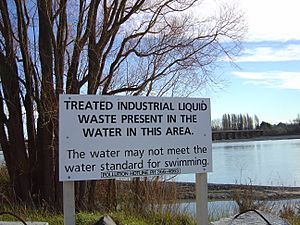Water pollution in Canterbury Region facts for kids

Water pollution in Canterbury, New Zealand, is a big problem. Most of this pollution comes from farms. But factories and cities also add to the issue.
The rules for water use are managed by Environment Canterbury. They follow a law called the Resource Management Act. If someone wants to take water for things like irrigation, they need special permission.
The city of Christchurch gets its drinking water from underground water sources called aquifers. These aquifers are located deep beneath the city.
Contents
Understanding Water in Canterbury
Canterbury gets less rain than other parts of New Zealand. This is because the Southern Alps block the rain clouds. The region usually gets about 500 to 700 millimeters of rain each year.
Water from melting snow and rain flows into the rivers on the Canterbury Plains. These rivers often have many small channels, which are called "braided rivers." The water from these rivers then helps to refill the underground aquifers.
For a long time, farms in Canterbury mostly grew crops and raised animals like sheep. But recently, many farms have changed to dairy farming. Dairy farming has grown a lot across the South Island. This type of farming needs a lot of water, which puts a big demand on Canterbury's water supply.
What Are the Water Problems?

Rivers and underground water (called groundwater) are getting polluted. The main pollutants are nitrates and E. coli. Nitrates come from things like fertilizers and animal waste. E. coli is a type of bacteria often found in animal and human waste.
In 2017, about 7% of the wells tested in Canterbury had nitrate levels higher than safe drinking water standards. Environment Canterbury checked 224 wells in 2015. They found that nitrate levels were increasing in 25% of these wells.
The Ministry for the Environment says that 77% of Canterbury's rivers and lakes are good or excellent for swimming. Only 4% are considered poor for swimming.
Water quality is also affected by "inorganic nutrients." These are chemicals that can make algae grow too much. These nutrients are usually low, but they increase closer to the coast. In 2000-2001, 28% of tested sites had "organic pollutants." These are harmful substances from living things or human activities.
The two main rivers in Christchurch, the Avon / Ōtākaro and the Ōpāwaho / Heathcote, also have pollution worries. Sometimes, during heavy rain, untreated sewage can flow into these rivers. Before 2010, treated water from the city's sewerage treatment plant went into the estuary where these rivers meet the sea. But now, a special pipeline sends this treated water into Pegasus Bay instead.
A big project called the Central Plains Water scheme plans to move water, build dams, and set up irrigation for a huge area of land. This project is meant to help farms.
In the Mackenzie Basin, many dairy farms wanted permission to expand. People worried about how this would affect water quality. The government stepped in to review these plans.
The town of Cheviot has had a special "boil water notice" since 2004. This means people there need to boil their drinking water to make it safe.
How Are We Fixing the Problem?
The Dairying and Clean Streams Accord was created by Fonterra (a big dairy company) and government groups. Its goal was to reduce pollution from farms that spreads out, not from a single pipe. However, some people say this plan has not fully reached its goals.
Recently, Environment Canterbury has made new, tougher rules for farms. Most farms now need "Farm Environment Plans." These plans help farms manage things like how they use fertilizers, prevent soil from washing away, manage irrigation, and protect waterways. For example, farms often need to fence off rivers and streams in areas where many animals graze. They also plant trees and plants along the water's edge.
New checks on water quality in Canterbury show that these new rules are helping. Levels of nitrogen, phosphorus, sediment, and E. coli are now improving at more places than they are getting worse. Only "turbidity" (how cloudy the water is) is still getting worse at some sites.
What Happens When Rules Are Broken?
When rules about water pollution are broken, there can be consequences. For example, companies or individuals who cause pollution can face fines. This encourages everyone to follow the rules and protect our water.
In 2012, a dairy farm company called White Gold Ltd was fined a large amount of money. This happened because they illegally let a lot of diluted dairy waste flow into waterways. These waterways then flowed into Lake Ellesmere / Te Waihora. People saw the pollution and reported it.

